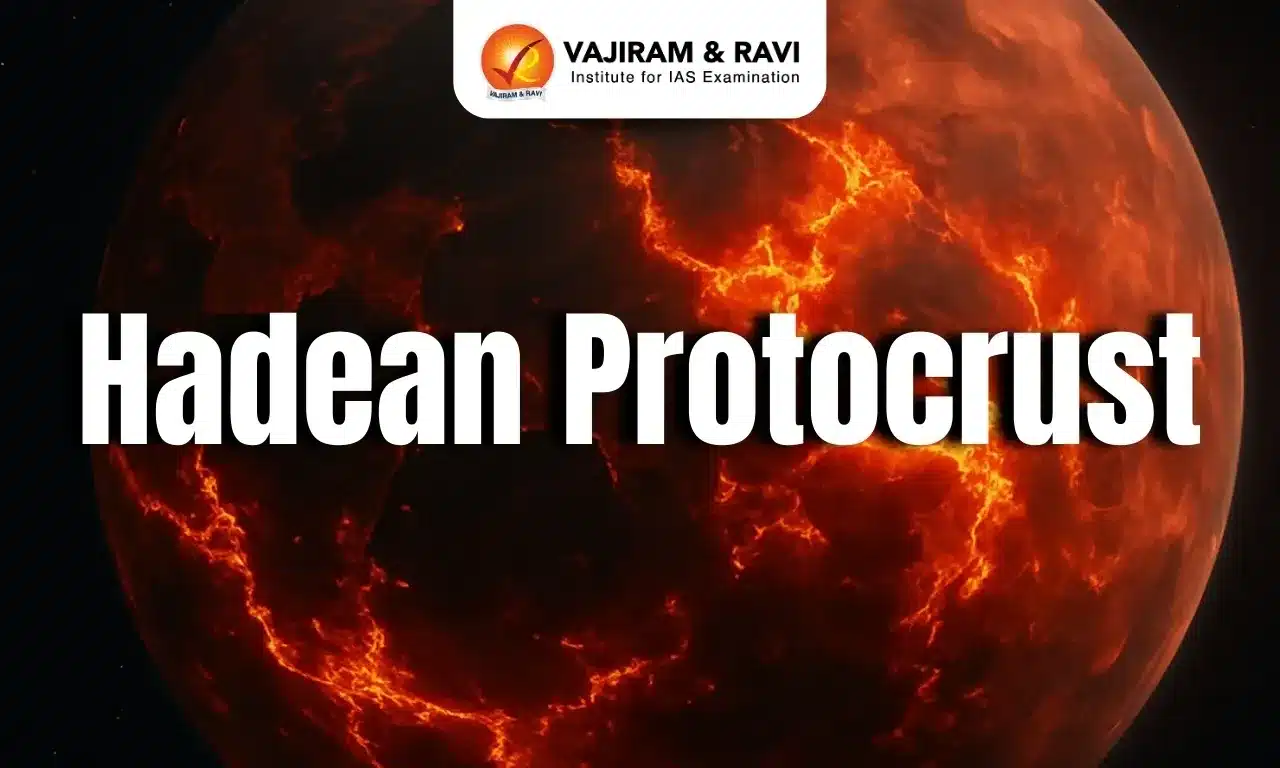Hadean Protocrust Latest News
A new international study led by Macquarie University, Australia, suggests that the chemical signatures attributed to plate tectonics were already present in the Hadean protocrust.
What is the Hadean Protocrust?
- The Hadean protocrust refers to the earliest known crust of the Earth—its outermost solid layer—that formed during the Hadean aeon, the planet’s first geologic era, which began around 4.6 billion years ago.
- This period is named after ‘Hades’, the Greek god of the underworld, due to the extremely hot, hostile, and unstable conditions that prevailed on early Earth.
Geological Conditions During the Hadean Aeon
- The Earth, within its first 200 million years, had a surface that was partially molten, with widespread volcanic activity and constant meteorite bombardment from space.
- During this time, the magma ocean—a vast reservoir of molten rock covering Earth’s surface—began to cool gradually.
- As the surface cooled, early fragments of solid crust began to form. These fragments were not stable and often broke off, while new layers solidified, creating a flaky, unstable crustal layer.
- Some thicker segments of this primitive crust eventually consolidated into the first proto-continents, floating on the underlying asthenospheric mantle—a semi-fluid layer extending up to 400 km beneath the surface.
Birth of Plate Tectonics
- As these crustal plates drifted across the mantle, they began to interact in various ways: colliding, sliding past, or subducting (diving under) one another.
- These early plate movements laid the foundation for plate tectonics, a key process in shaping the Earth’s geological features.
- Over time, these interactions left distinct chemical signatures in the Earth’s crust, enabling scientists to reconstruct the history of tectonic activity.
Hadean Protocrust FAQs
Q1. What is the Hadean Protocrust?
Ans. It refers to the earliest crust of the Earth, formed during the Hadean Eon (4.6 to 4 billion years ago).
Q2. Why is it important in geology?
Ans.It provides insights into early Earth formation, plate tectonics, and crust evolution.
Q3. Where has evidence of Hadean Protocrust been found?
Ans. Mainly in zircon crystals from the Jack Hills, Australia—some of the oldest known materials on Earth.
Q4. How does it relate to continental crust formation?
Ans. It suggests that the continental crust began forming earlier than previously thought, possibly influencing early life.
Q5.What methods are used to study it?
Ans. Isotopic dating (U-Pb in zircons) and geochemical analysis are primary tools.
Source: TH
Last updated on December, 2025
→ Check out the latest UPSC Syllabus 2026 here.
→ Join Vajiram & Ravi’s Interview Guidance Programme for expert help to crack your final UPSC stage.
→ UPSC Mains Result 2025 is now out.
→ UPSC Notification 2026 is scheduled to be released on January 14, 2026.
→ UPSC Calendar 2026 is released on 15th May, 2025.
→ The UPSC Vacancy 2025 were released 1129, out of which 979 were for UPSC CSE and remaining 150 are for UPSC IFoS.
→ UPSC Prelims 2026 will be conducted on 24th May, 2026 & UPSC Mains 2026 will be conducted on 21st August 2026.
→ The UPSC Selection Process is of 3 stages-Prelims, Mains and Interview.
→ UPSC Result 2024 is released with latest UPSC Marksheet 2024. Check Now!
→ UPSC Prelims Result 2025 is out now for the CSE held on 25 May 2025.
→ UPSC Toppers List 2024 is released now. Shakti Dubey is UPSC AIR 1 2024 Topper.
→ UPSC Prelims Question Paper 2025 and Unofficial Prelims Answer Key 2025 are available now.
→ UPSC Mains Question Paper 2025 is out for Essay, GS 1, 2, 3 & GS 4.
→ UPSC Mains Indian Language Question Paper 2025 is now out.
→ UPSC Mains Optional Question Paper 2025 is now out.
→ Also check Best IAS Coaching in Delhi

















